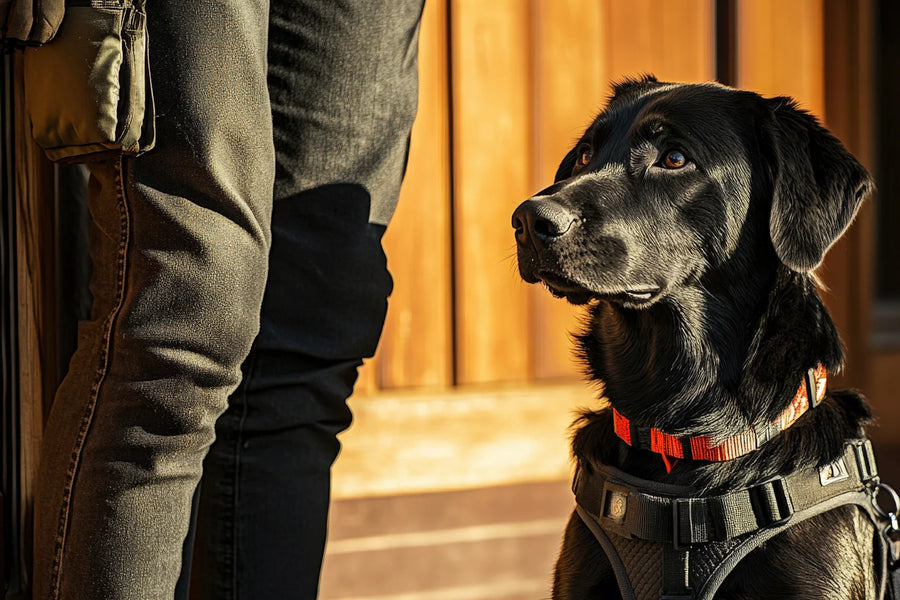Arthritis is a common condition in dogs, especially as they age. It causes joint inflammation, stiffness, and pain, which can make everyday movements difficult.
While arthritis can’t be cured, there are many ways to help manage your dog’s joint discomfort at home. Simple adjustments — modifying their environment, providing joint-supporting nutrition, and incorporating gentle exercise — can significantly improve their quality of life.
At Pet HealthWorks, we believe understanding your dog’s needs and making proactive changes can help them stay active, comfortable, and happy for as long as possible.
How Can You Recognize Arthritis in Dogs?
Arthritis in dogs often develops gradually, making it easy to overlook the early signs. Common symptoms include stiffness, limping, difficulty getting up or lying down, reluctance to jump or climb stairs, and a noticeable decrease in activity. Some dogs may also show irritability, licking of sore joints, or changes in posture.
Certain factors increase a dog’s risk of arthritis, including aging, obesity, joint injuries, and breed predisposition (such as Labrador Retrievers, German Shepherds, and Golden Retrievers). If you notice these symptoms, it’s important to consult your veterinarian for an accurate diagnosis and treatment plan.
Early intervention can make a significant difference in slowing arthritis progression. Monitoring your dog’s mobility, weight, and behavior will help you catch changes sooner.
What Steps Should You Take To Create a Dog-Friendly Home?
Even without a diagnosis of arthritis, many senior dogs may experience joint discomfort. Making your home more accessible and comfortable for an older dog can greatly improve their quality of life, and it’s not too hard to do. Since joint discomfort makes movement difficult, simple modifications can help reduce strain.
Start by providing soft, orthopedic bedding to support their joints and minimize pressure points. Elevated beds or cushioned mats can also help dogs get up and down more easily. Place non-slip rugs or carpet runners on slippery surfaces like tile or hardwood floors to prevent slips and falls, which can worsen joint pain.
Minimize the need for excessive jumping by using pet ramps or stairs for beds, couches, or cars. Raised food and water bowls can also make mealtime more comfortable for dogs experiencing stiffness in their neck or front legs.
Consider adjusting their living space by keeping essentials (like their bed, food, and water) on the ground floor to reduce the need for climbing stairs. If your dog struggles with cold weather, keeping them warm with a sweater or heating pad can also help ease stiffness.
When you make these small yet impactful changes, you can create a safer and more supportive environment, helping your dog maintain their independence and mobility despite joint discomfort.
How Can You Support Joint Health With Nutrition and Supplements?
Maintaining a healthy weight is a key factor in managing discomfort. Excess weight puts additional stress on joints, worsening pain and mobility issues. Feeding an appropriate portion size and choosing a high-quality diet rich in lean proteins, healthy fats, and essential nutrients can help keep your dog at a healthy weight.
Proper nutrition also plays a crucial role in managing discomfort and supporting your dog’s joint health. A well-balanced diet with anti-inflammatory ingredients can help reduce stiffness and promote overall well-being.
Omega-3 fatty acids are known for their anti-inflammatory properties and can help soothe joint discomfort. A dog joint health supplement that has Omega-3s can help maintain mobility and soothe joint discomfort in dogs.
Can All Joint Supplements Deliver the Same Results?
There are many joint supplements on the market, including fish oil supplements that contain omega-3s and traditional glucosamine/chondroitin supplements. However, Antinol Plus is a superior option to traditional joint supplements for several reasons.
First, Antinol Plus is not in the same category as traditional joint supplements — it’s made from New Zealand green lipped mussel oil and Antarctic krill oil. Second, Antinol Plus is superior to traditional supplements because it delivers powerful joint and mobility support in a much smaller, more concentrated dose.
Unlike many joint products, Antinol Plus is clinically studied, with studies proving its effectiveness in improving mobility in as little as 30 days. Its ingredient purity and transparency ensure that what you buy is exactly what was studied.
Make sure to always consult your veterinarian before introducing new supplements or dietary changes to ensure they suit your dog’s specific needs. A tailored nutrition plan can make a significant difference in keeping your dog comfortable and active.
What Are Gentle Exercise and Mobility Support Options for Older Dogs?
Regular, low-impact exercise is essential for managing joint discomfort in dogs because it helps keep their muscles strong and joints flexible without causing additional strain. Activities like walking, swimming, or gentle play sessions are ideal for dogs with arthritis.
Swimming is especially beneficial because it provides a full-body workout while being easy on the joints due to the buoyancy of water. Be sure to adjust the intensity and duration of exercise based on your dog’s age, breed, and severity of discomfort.
Short, frequent walks are often better than longer, strenuous sessions. Avoid high-impact activities like running on hard surfaces or excessive jumping, which could worsen joint pain.
Providing mobility support, like joint braces or slings for older or severely affected dogs, can assist in movement during walks or bathroom trips. Also, stretching exercises can improve flexibility and range of motion. Regular, gentle exercise can help manage discomfort and maintain your dog’s mobility, allowing them to remain active and engaged in daily life.
How Can You Keep Your Arthritic Dog Comfortable?
Ensuring your dog’s comfort is paramount when managing joint issues. Start by providing an orthopedic bed that offers ample support to alleviate joint pressure while they sleep. Memory foam or cushioned beds are ideal because they relieve pressure on painful joints.
Keep your dog warm during colder months. Chilly temperatures can exacerbate joint discomfort, so consider using a dog sweater or heating pad for extra warmth and comfort.
It’s also important to create a stress-free environment. Ensure your dog has easy access to their food, water, and bathroom areas, eliminating the need for unnecessary movement. Keeping your dog on a routine schedule for meals and bathroom breaks can help reduce anxiety and discomfort.
Lastly, gentle massages and physical therapy can provide added comfort by increasing blood circulation and relieving stiffness. Regularly monitor your dog for signs of discomfort, and adjust their care routine to make them as comfortable as possible.
Wrapping Up
Managing joint discomfort in dogs requires a comprehensive approach that includes a supportive environment, proper exercise, and nutritional support. By creating a dog-friendly home, incorporating joint supplements like Antinol Plus, and keeping them comfortable, you can significantly improve your dog’s quality of life.
Regular care and attention will help them stay active, comfortable, and happy despite their joint issues.
Sources:
Is Swimming Therapeutic for Senior Dogs? | American Kennel Club




